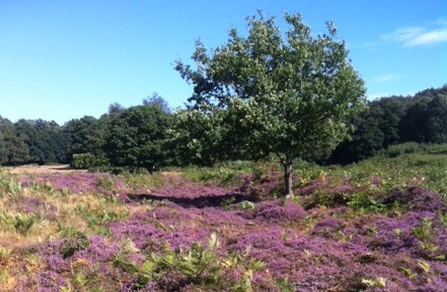Why is there heathland at Hothfield? Because of the sandy soil (Folkestone Beds) and underlying clay (Sandgate Beds). Sand is inert, free draining so can’t hold on to nutrients, dries out in summer, and is easily eroded. In places the clay creates an impervious pan preventing water from draining away and bog or fen results from the partial decay of plant and animal material. As living things create order out of disorder in even the most inhospitable environment, each soil type becomes colonised by the plants that are adapted to the available level of anchorage and sunlight, of water, air and accessible nutrients in the soil and conditions for root growth. The mutually dependent micro-organisms, insects, birds and animals adapted to these specialist conditions follow.
Encroaching trees and scrub, animal and human activity including air pollution, all gradually alter soil composition, usually enriching it. Warden Ian Rickards explains: “Low nutrients in the soil are incredibly important for a heathland, as nutrients increase it becomes more attractive for more vigorous plants and grasses which then out-compete the rare fragile plants like heath spotted orchid, hare bell, sundew and lousewort. When we have machines available we carry out scrapes, taking off the top layer of nutrient enriched soil, often dominated by stinging nettles and willow herbs, to reveal the poor sandy soil beneath. This will then get re-colonised by the heathland plants.”
One sunny sandy scrape near the old football field is now early-stage heathland, with just ground-hugging plants but much insect and micro-organism activity. Scrapes made in the more nutrient-rich fen in autumn 2018 will colonise more quickly. Bare soil is also space for reptiles to bask on, beetles to hunt across, and bees and wasps to dig into for nests. Plus the myriad invisible burrowers aerating, breaking down and transferring dead plant and animal material or just hibernating, a niche habitat just below your feet.
As Ian explains: “We often use the scraped material to improve the paths and trails around the reserve. It is understandable that visitors will want to avoid wet and muddy paths, and will often walk on the edges or create new routes. It is easy to see how this damages the heathland vegetation, with heather being particularly sensitive to trampling.” Heather can grow for up to 40 years and all stages of growth are essential to different insects. Ian continues: “Very quickly paths get wider and wider, or new paths become established with the solid blocks of heather becoming divided up into smaller and smaller areas. Improving the paths is hard work and done with spades, wheel barrows and our wonderful team of volunteers. When visiting you can make a big difference, please stay on the main established paths and wear footwear suitable for putting up with the muddy sections we haven’t been able to improve.”
Hothfield Heathland is open to everyone. Please keep dogs in check especially around children and animals, and clean up including in the Triangle compartment. Trails are signposted and marked on entrance maps, along with the location of livestock. The noticeboard down the main slope from the Cade Road car park gives recent wildlife sightings.
For email alerts on the location of the livestock on Hothfield or if you would like to come and join us on one of our volunteer task days (baked potatoes provided!), please contact Ian Rickards on 01622 662012 or ian.rickards@kentwildlife.org.uk.

